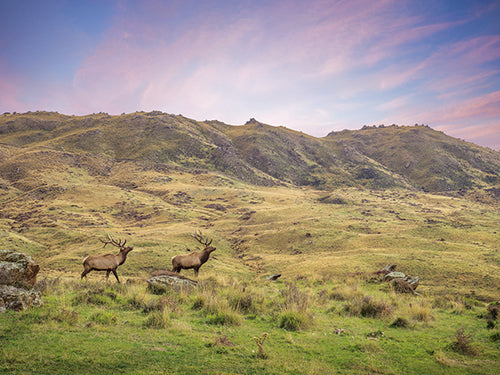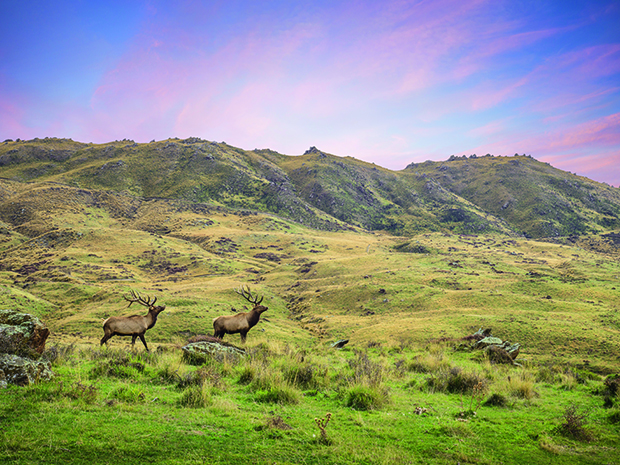
These bull elk are probably 500 SCI (the measurement of the total antler area) in the currency of the hunting business. John has stock breeding in his blood, with both grandfathers running beef studs (one angus, the other hereford) and a merino stud. John breeds elk.
A South Island high-country farm is attracting high-value international tourists, thanks to New Zealand’s reputation as a hunting destination and a family’s determination to diversify.
Words: Kate Coughlan Photos: Rachael McKenna
The wind on the top of the ridge separating the plains of the Maniototo from the Ida Valley can knock an adult to their knees, but the view will surely get them right back up again. In the crisp winter air, and 80 kilometres to the west, are the improbably spiky peaks of The Remarkables, clearly visible like a jagged fringe on the horizon. Mt Aspiring, even further north and some distance west of Lake Wānaka, punches into the skyline with a determinedly pointy fist. Two valleys over, at the southern end of the Dunstan Mountains, is Leaning Rock, through the ages a valuable sentinel for travellers to the vast spaces of Central Otago. And to the northeast are the Kakanui and Hawkdun Ranges; directly to the east is the Rock and Pillar Range.
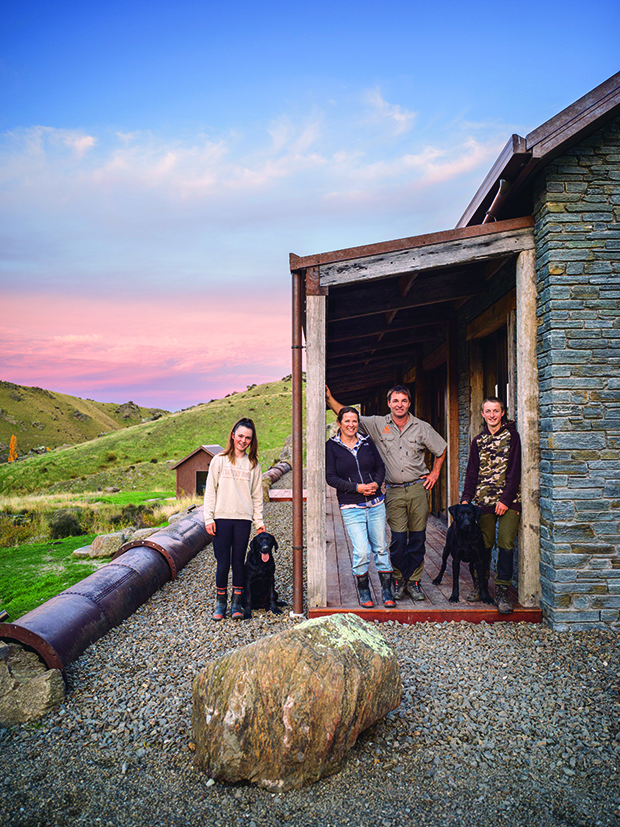
Every generation brings something new to a property. John and Mary Falconer, with their teenage children Lucy and Charlie, are proud of their new hunting lodge on their land close to Ranfurly. “It’s just our small family doing this, not a huge corporation,” says John. Pointer-cross labradors Bruiser (left) and Tupac are ideal hunting dogs and loving pets.
This is the boundless vista from John Falconer’s boundary fence, tracing several kilometres along the top of the well-named Rough Ridge. John is the third generation of his family to farm this land. Grandfather Laurie Falconer returned from World War II with only one arm and succeeded in a ballot for land south of where John is today. When an opportunity arose to purchase land with two streams and a water right, Laurie moved his family to the current farm. On this land — with Stoney Creek at the southern end and Waitoi Creek at the north — Laurie bred hereford cattle and merino sheep. John’s father, Charles, continued the stud operations and, in the late 1980s, added deer to the farming business before suffering a debilitating stroke. His son John, then aged 23, was in North America working on elk properties and intending to spend his autumns as a hunting guide. John came home to take over.
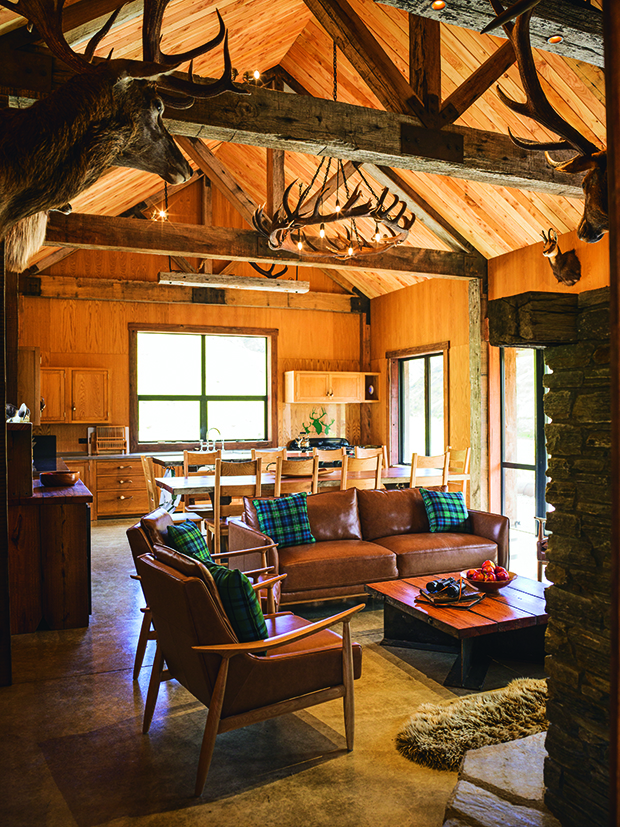
John sourced the australian hardwood timber, milled it himself, used stone from the farm, supplied the diggers for the excavation work and was involved in every step of the lodge design with architectural designer Mike Sowerman.
In the nearly three decades since, John and his family (including mother Jane, wife Mary and now-teenage children Lucy and Charlie) have added three more farms to their holdings, developed red deer and elk studs, bred venison for export meat and for velvet, pioneered a system for milking deer (and discontinued it) and, in more recent years, built a trophy hunting business into a significant revenue stream.
So strong was the hunting business that before Covid-19, John and Mary pushed the “go” button on a project they’d been considering for years — building a substantial lodge in a remote part of their farm so that hunters (primarily international) could stay longer, shoot a wider range of trophy animals and bring their families.
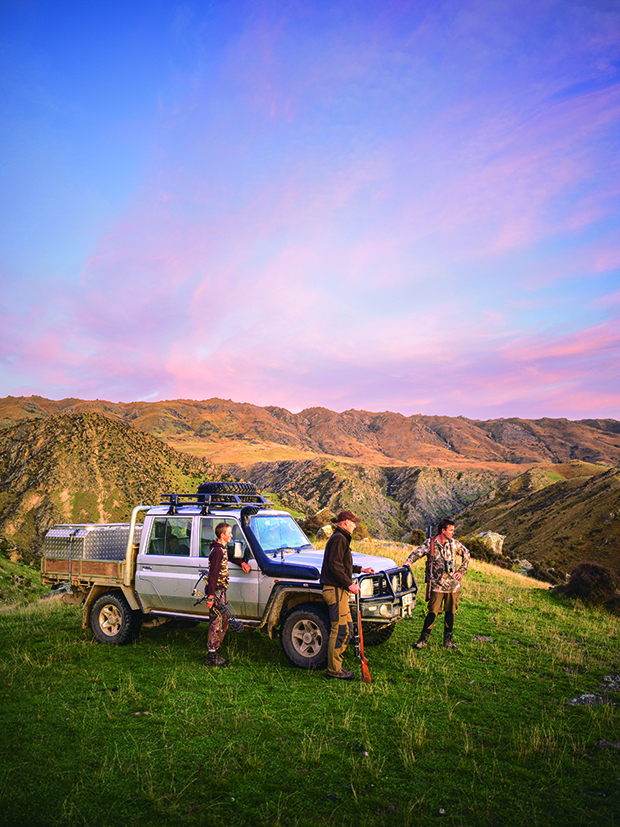
The higher altitudes of John’s farm are effectively a massive wildlife park with multiple species free-ranging among the tussocks. Here John, son Charlie (left) and family friend Duncan White check that all is well near the tops.
“Farmers don’t do things short term, and I’d been thinking about this for a long time,” says John. “So even though Covid disrupted things, I always knew that hunters would come back, and they’d bring their families if they could. To attract the top percentage of hunters, we need to host them on the property with top-quality accommodation.
“That’s the reason for building the lodge, pure and simple. And it has worked. My guests have a better experience, stay longer and spend more. Before we had the lodge, I’d get one client for one day for one species. I need 100 nights a year of hunting clients, and the investment will work out. And we’ve got that this year and are pretty well booked for next year.”
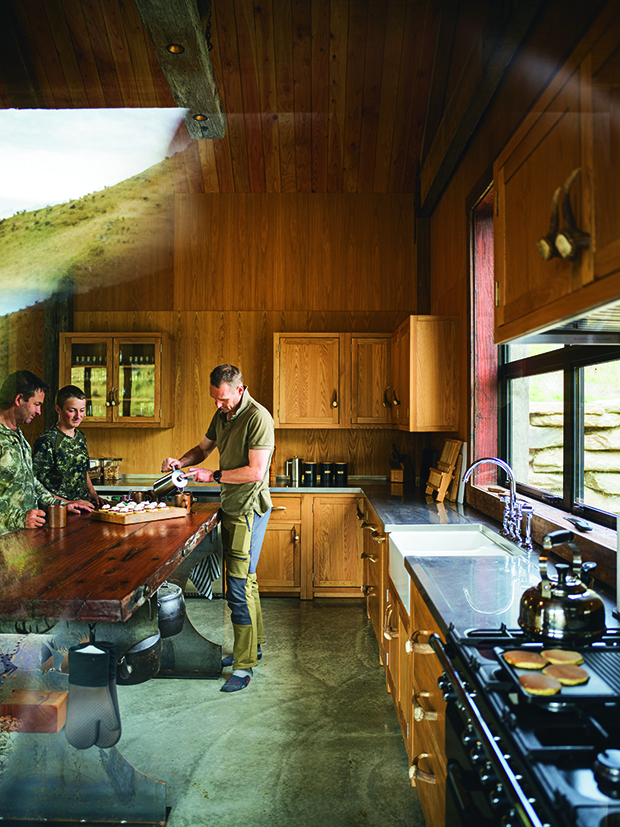
The kitchen table and cabinetry were designed and built by John. Cream and jam pikelets, made on the Falcon Classic 110 all gas range cooker by F.L. Bone, for morning tea in the off-grid, solar-powered lodge.
On a still day on the craggy tops of the Falconer’s farm, the cries of New Zealand’s native falcon, the kārearea, echo above the schist rocks and over the tussock-clad valleys. Skylarks add their trilling call as they ascend steeply. Meandering up and down the steep gullies of the picturesque 2400 hectares are a veritable safari of wild animals; red deer, elk, fallow deer, wild goats, feral pigs, turkeys and, the most recent arrivals, a herd of north american bison. It is a hunter’s paradise, with the goal of most hunters being to bag several different game species.
“One or two generations ago, big game hunting was the thing to do if you were a rich man; lions, rhinos and elephants,” says John. “That is not as trendy as it once was. What is popular now in game hunting circles are high-altitude species with big horns and capes, such as tahr. That’s where the money is, and it is far harder to hunt in the mountains than to drive around in a Land Rover shooting at a hippopotamus sitting in a water hole on the side of the Zambezi River.
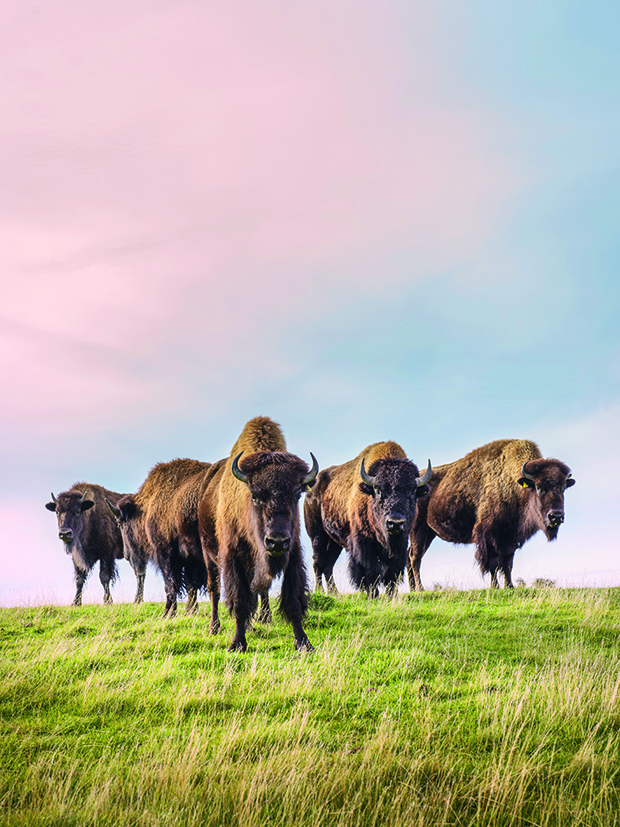
Two years ago, John introduced a small herd of north american bison, not because they are rare but because they are “another cool animal with a shaggy inquisitive nature that’s appreciated”. In two seasons, six bison calves have been born.
“Hunters coming to New Zealand generally want five species, some shooting between three to 10 animals. New Zealand’s trophy species are chamois, tahr, red and fallow stags, arapawa rams, elk bulls, feral goats and pigs, and even turkeys. And our unique story is that our animals are bred here on our land, live here their whole lives, and I am both the farmer and the professional hunting guide. It is a story our clients like.
“So when a guy rings me from North America, or wherever in the world, wanting to book for the 2024 season, I tell him what species he can expect to hunt and the price and that I can accommodate him and his family and guide him while he hunts.”
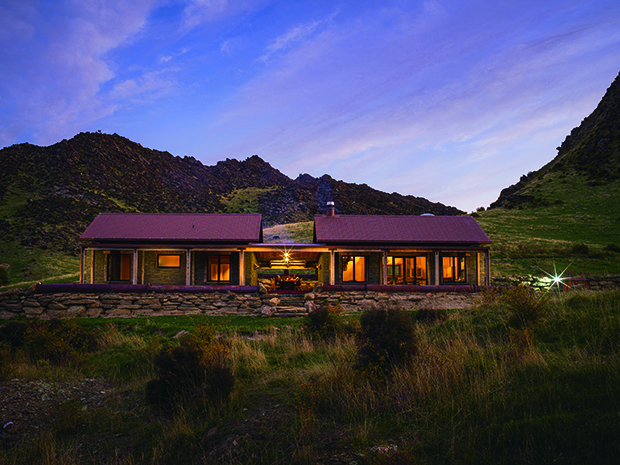
The lodge is near a goldmine dating back to the 19th century. The verandah front is edged with a steel sluice pipe from the old workings — there were no hot showers, cosy beds, nor three-course meals for goldminers on-site in those days.
Trophy animals are charged by the size of their antlers using the recognised SCI (Safari Club International) score system. Most of John’s stags are between 350 and 500 SCI (the total measurement of the antlers), and range from a few thousand dollars up to $50,000, with most being between $5000 and $10,000. “Not everyone wants the same thing,” says John. “Most hunters want as big as they can afford on the SCI score as well as the breadth, width and form of the stags, or their cape, which is the hair about their necks and is most attractive in late autumn and early winter. Antlers, the most important thing hunters want, are one of nature’s marvels.”
He sees no decline in the sport’s popularity, quite the opposite, with an increase in women hunters joining their husbands or hunting on their account.“Our animals get more and more valuable the older they get, which is the opposite of sheep, dairy or beef cows. They’re most valuable when fully mature, with trophy stags averaging $5000 (red stags) to $8000 (elk bulls). If sent to the freezing works for venison, they’d be worth between $400 and $800.”
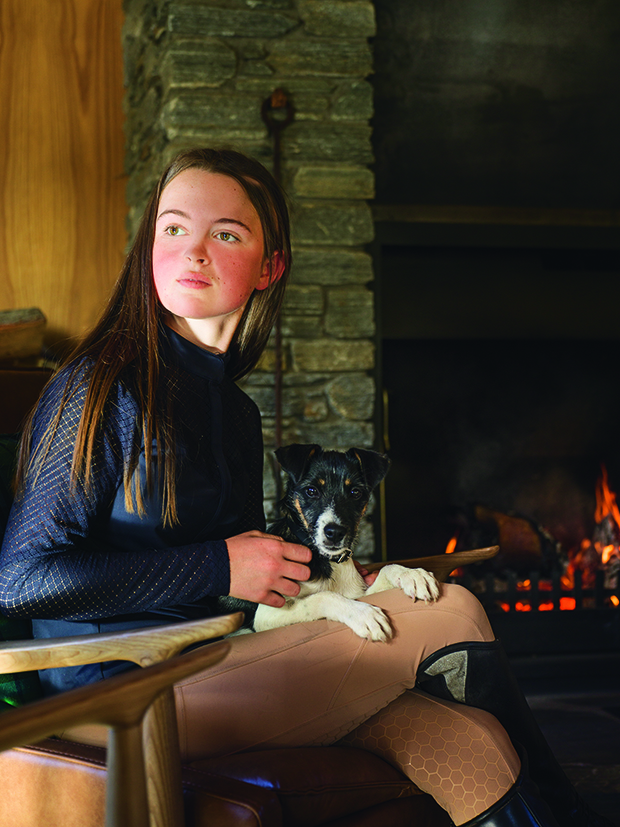
Keen rider Lucy enjoys exploring the farm and visiting the lodge on horseback when she comes home from boarding school in Dunedin. The family’s newest member is grandmother Jane’s fox terrier puppy, Poppy.
John breeds his elk and red deer for high growth rates (for meat production) and good antlers (for either velvet or trophy shooting). The annual January stag sale on the farm sees some of the three-year-old elk bulls sold to other breeders. The rest are kept for the export venison market and breeding. Once they’re beyond that, and if they are to become trophy animals, they’re released into the highest area of the farm.
When that happens, Farmer John becomes PH John (professional hunter). When a client books, he (or she) specifies what SCI-size trophy they want, and even that far in advance, John knows pretty much the exact animal he will sell them. He keeps enough animals for the four-month hunting season from mid-February to mid-June.
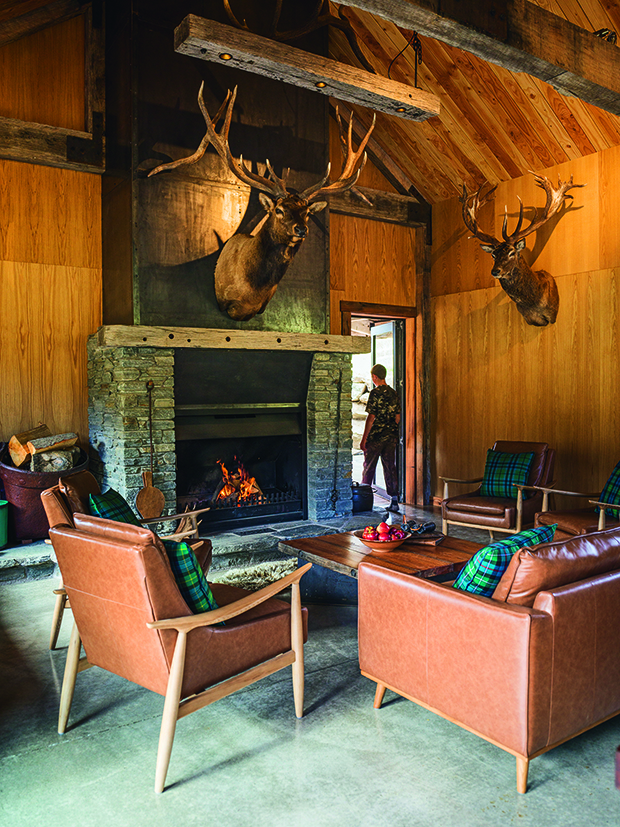
John was delighted to find he had a strong creative streak and took control of the interior look and feel of the lodge, including selecting four tartans relevant to the family’s shared Scottish heritage (his being Roberts, McKenzie and Falconer, and Mary’s Gordon) and designing and often building the interior fittings. The six-metre stud also provides plenty of scope to display trophies.
“When my client arrives, I have to assess their ability to not only hunt well but to stalk effectively. If someone doesn’t look like he’d make it up and down hills, I need to get above the prey so my client can come down. Others are so fit we don’t use vehicles at all. I like to talk to them and find out what animals they want. Some will say mass or width or length. So, then I know I need a good, clean wide 450, for example. “We don’t start the hunt until we have identified the one we want from about half a kilometre away. Sometimes a client will see something else and ask how much it is.
“It can take quite a while after that, especially if we spook an animal. Bow hunting can take longer as the range is 25 to 40 metres. Bow hunters make my heart flutter a bit as they can potentially be a lot more work because of the close range required. That said, most bow hunters are fit, and a modern compound bow can be as deadly, if not more so, than a rifle.
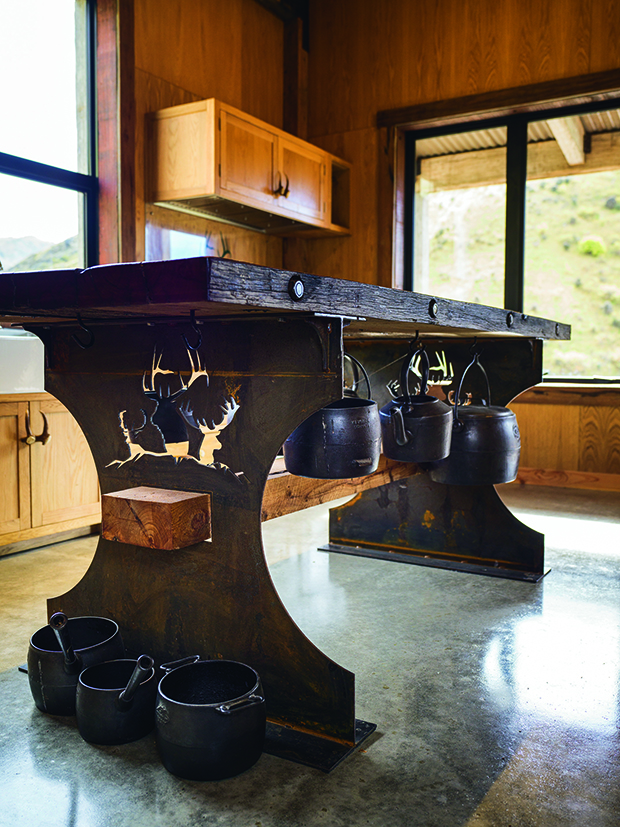
John enjoyed doing all the steelwork himself, including the fire surround and cutting out deer silhouettes in the table base. He also used a set of antlers to create a table for the outside area by the vast outdoor cooking fire.
“Generally, the animals aren’t aware that they’re being hunted, so they are not full of fear and adrenaline. The goal is to make it as much of a hunt as possible for the client and get close range. Long-range shooting is not good hunting in my book. The art of hunting is getting close enough to get a clean kill. We need ethical kills, as the last thing we want is a wounded animal or any pain for them. That’s part of my skill as a guide, to suss out my clients’ ability and deliver them the right opportunities.”
John is happy to be doing something other than the traditional work of a deer farmer. “You get to the stage where you are sick of drenching deer, fixing fences, driving tractors and feeding out.
I took over so young, and when I say took over, I mean I was hiring and firing staff, dealing with the bank manager and paying bills when I was 23. A lot of my farming friends weren’t doing that until they were in their 40s.
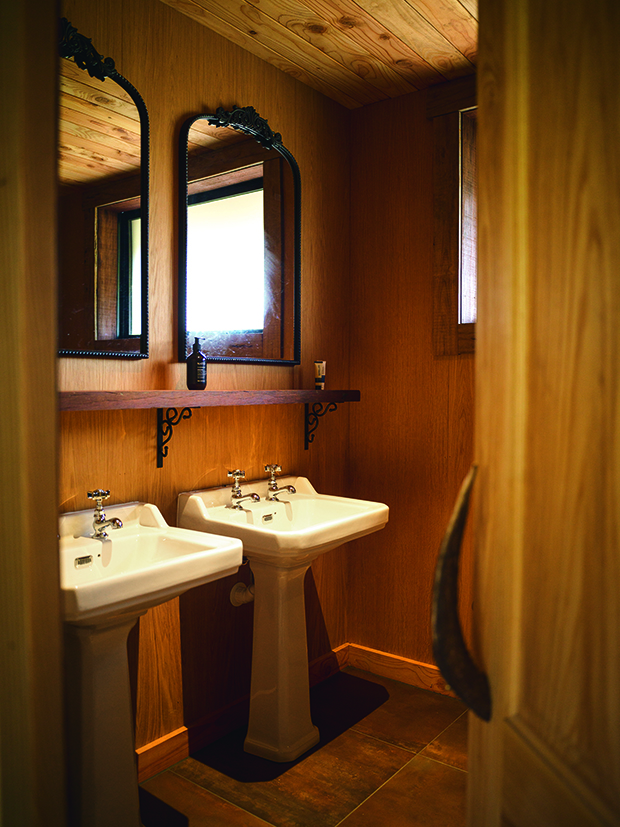
“Ideally, I’ll be hunting and hosting clients as I get older, and my son Charlie can be the farmer. I enjoy the contact with a lot of very interesting and successful people as well as the challenge of maintaining the skills needed to be a good guide. I want my clients to have the sort of excellent experience they treasure and go home to tell their mates about. And I am very relaxed about how the business might evolve. The property has a very attractive landscape, and with such a broad range of species, it’s a bloody great wildlife park. We could end up with people coming to cruise around on photographic hunts or archery competitions with static targets. Who knows? This lodge will be here for 100 years at least. So that’s my intergenerational commitment — to leave lots for my family to build on.”
THE SCOOP ON ANTLERS
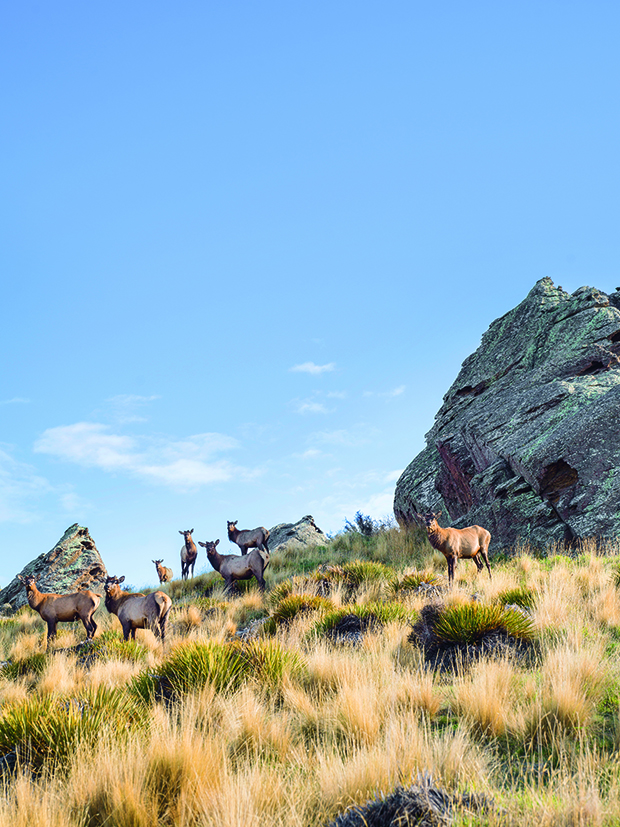
The Waitoi Creek hunting business is unique. “There are not a lot like ours as most source their animals off farmers and don’t have a lot of species. Very few own the land, breed the animals and guide and lodge the hunters.”
Male deer grow antlers for protection, to mark territory, compete with other males for mating rights, and show dominance in areas where food resources are scarce. The larger the antlers, the better the status symbol they provide both for the stag and the trophy hunter.
Antlers grow, harden and drop off all in an annual cycle. From spring, the buds on the stag or bull head will begin to sprout antlers growing up to two centimetres a day. Once summer is over, the blood supply to the growing antlers ceases, and the antlers harden from a softer velvet to the hard stage.
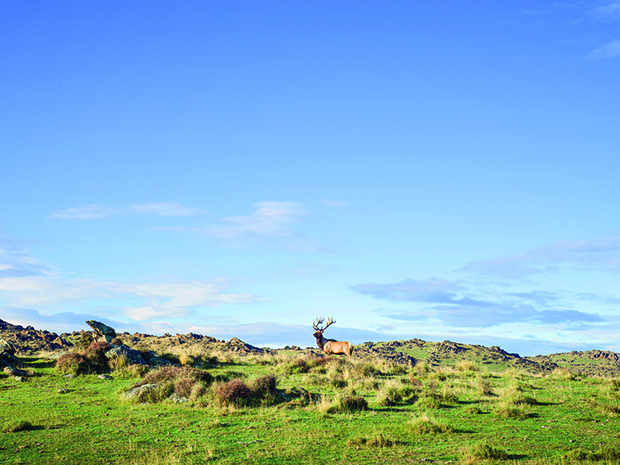
Elk bulls can generally hold 20 or so hinds until a younger elk bull comes along — or one with more impressive antlers.
As deer age, they will grow bigger antlers. Antlers grow very quickly — velvet (as the prehardened antler is known) is the fastest-growing animal tissue in the world.
Velvet is highly prized in some cultures, predominantly Asian, for health-promoting benefits. It is a growing market, especially in South Korea and China.
Once the blood flow to the antler has ceased in early autumn, the antlers harden, and eventually, in winter, they drop off.
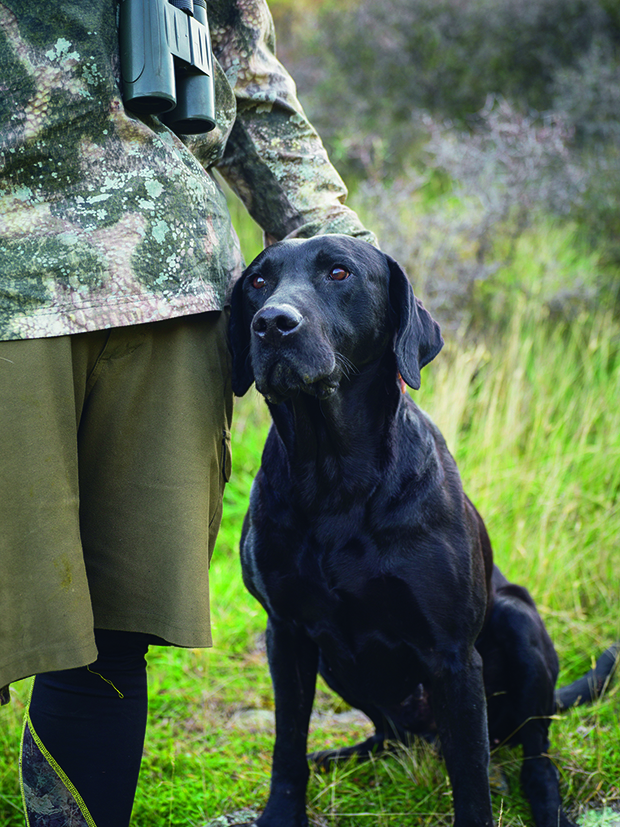
Curious fact: the closer deer live to the equator, the smaller their antlers.
John’s clients always take their antlers home: “One hundred per cent. That is the prize they’ve come for, and I’ve seen photos of their lodges at home, and every inch of every wall is covered with antlers or horns. These people are often seriously wealthy, and hunting is their big passion. Some of them hunt the world in every season. They come from everywhere; the United States is a big market, but also Central Asia, and lots from Europe and Australia.”
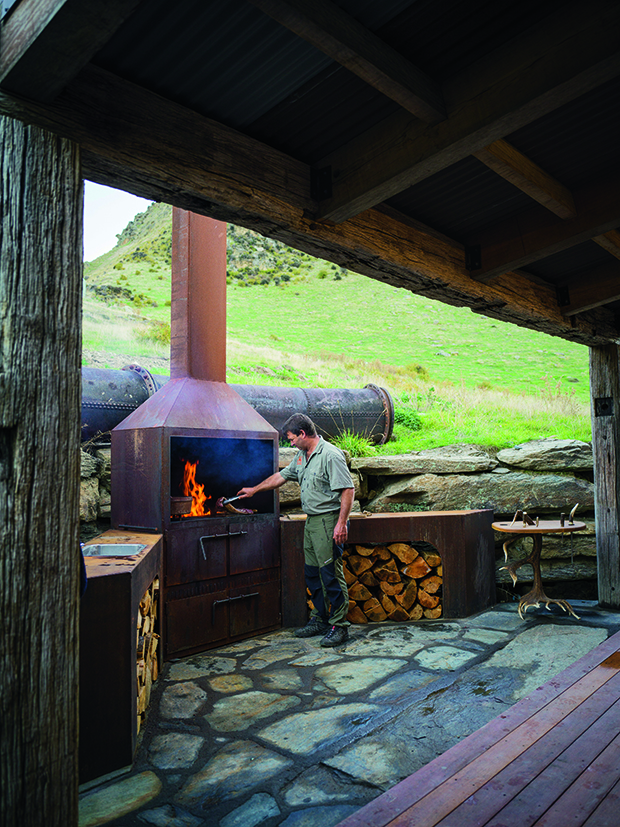
As the international trophy hunting season only runs for four months (February to June), John will open the lodge to domestic tourists for the hunting off-season. The off-grid, fully catered lodge sleeps six and is accessible by four-wheel drive. The local Maniototo area has many attractions for both domestic and international visitors, including the world-class garden of John’s mother, Jane Falconer, Clachanburn Country Garden (NZ Life & Leisure, May/June 2016).
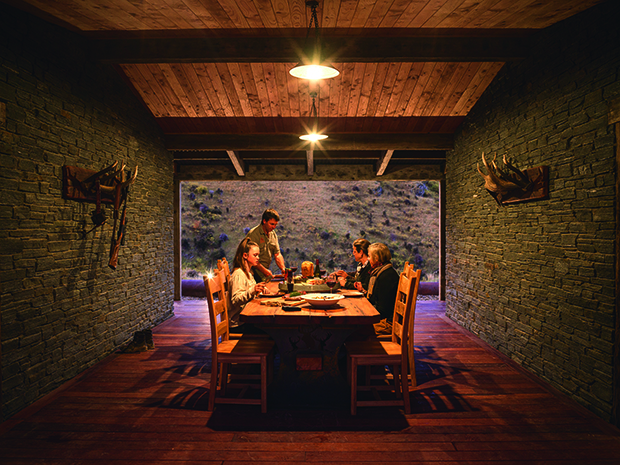
Charlie also discovered creative talents, using upturned gold pans to make lights for the outdoor dining area. Here the family is joined by the family matriarch (and John’s mother) Jane Falconer, creator of the renowned Clachanburn Country Garden nearby.
There are also activities in nearby Naseby, including the indoor curling rink, a skating rink, ice luge and swimming dam and the Royal Hotel’s excellent food. Other local attractions include world-class trout fishing in the Taieri River and the historic village of St Bathans and its haunted hotel, The Vulcan. Whisky and gin distillery tours are on offer at Lammermoor Distillery.
Price per night: $2000 for four people ($2500 for six), fully catered (drinks included).
Love this story? Subscribe now!
The post Making its mark: This Otago luxury lodge has a unique offering for keen hunters appeared first on thisNZlife.

